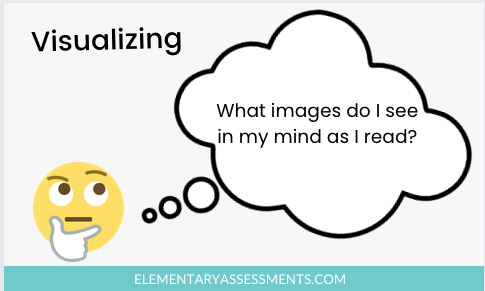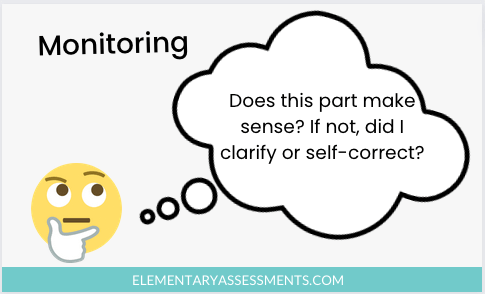There are students who read without thinking much about the words they’re actually saying.
They are good decoders but their comprehension isn’t so great.
That’s why it’s essential for teachers to teach the concept of reading is thinking.
Reading is thinking involves students reading for the purpose of understanding a book on a deeper level.
This involves teaching reading comprehension strategies in the form of inferring, visualizing, making connections, predicting, summarizing, questioning, and monitoring information.
It’s not enough to assume that students already know how to do this.
For many, this concept has to be explicitly taught through leveled or guided reading programs.
This post outlines and explains the 7 comprehension strategies of reading is thinking in a way that will help teachers teach this information to students in an easy-to-understand way.
Reading Is Thinking Strategies
When clarifying for comprehension, students should ideally be able to implement the following reading and thinking strategies.
1. Infer.
Sometimes authors convey messages without doing so directly.
It is up to the reader to use text clues, picture clues, and even prior knowledge to infer what message the author is sending.
This is how good readers construct meaning from a book.

2. Visualize.
Good readers’ minds fill with images that represent what’s occurring on the pages of the book.
This subconscious act (triggered by personal experiences and prior knowledge) helps readers deepen their comprehension of the text because visuals engage readers – resulting in greater understanding.

Unfortunately, some students don’t visualize as they read.
So teaching students how to create mental images as they read is important in aiding their reading comprehension.
Related Content:
3. Make Connections.
When we make a connection with something or someone, we tend to relate to it more resulting in a better understanding of the person or thing.
That same logic applies to making connections while reading.

If a student experiences a text-to-self, text-to-text, or text-to-world connection while reading, he or she will most likely construct greater meaning from the book because of the shared experience.
4. Predict.

Before, during, and after reading, it’s important for students to use clues to infer what they think will happen next.
Predictions are based on prior knowledge and background experiences.
5. Summarize.

The ability to retell the most important parts of a book selection is an essential skill that shows teachers that students are comprehending what they are reading.
This strategy often requires a significant amount of teacher modeling, especially with younger students.
The easiest way to begin helping students learn summarizing is by prompting them to answer the 5Ws (who or what, when, where, why) after reading a selection.
6. Question.

Some students are naturally inquisitive and will ask good questions as they read – strictly out of curiosity.
Others need assistance evoking their questions.
Asking questions helps students make sense of the reading, prompting them to dig deeper within the book or from their own prior knowledge to find answers.
In addition to asking good questions, great readers are able to answer a variety of leveled questions that demonstrate their understanding of the book.
See Prove It Reading Strategy which helps students answer questions strategically.
7. Monitor.

The strategy of monitoring shows teachers immediately if students are thinking about what they are reading.
When a student self-corrects, clarifies or fixes any mix-ups while reading, it’s proof that his mind is actively engaged in comprehending the text.
Reading is Thinking: Q & A
Is reading a form of thinking?
Yes, reading is a form of thinking. When a student reads, he or she is actively engaging the mind in various cognitive processes such as evaluation, synthesis, comprehension, and analysis.
The student is also making connections between prior knowledge and new learning.
What is the connection between reading and thinking?
Reading and thinking are connected because reading involves the active engagement of the mind such as analysis and comprehension processes. These are two types of thinking.
What are the reading and thinking strategies?
The 7 comprehension strategies of reading and thinking are questioning, monitoring, summarizing, inferring, visualizing, making connections, and predicting.
Final Thoughts
Now you have the knowledge to support students as they learn the 7 comprehension strategies of reading is thinking.
Notice that the foundation of these strategies consists of prior knowledge plus a variety of background experiences.
So help cultivate students’ prior knowledge/background experiences by exposing them to lots of books, educational videos, and field trips.
If you found these strategies helpful, you may like… Reading Is Thinking anchor chart and/or this attractive Reading is Thinking Bulletin Board Set.
